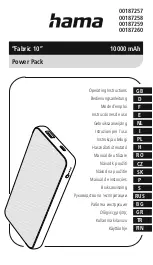
24
2.2.
Batteries
The battery temperature sensor must be placed as close to the battery as possible.
Battery wiring instructions
The power supply takes a resistance measurement of the battery mesh every 4 hours. The trigger threshold of the fault is
13 m
Ω
±
10 %
in 24V and 26m
Ω
±
10%
in 48V. Exceeding this threshold is signalled by a battery fault and means that the
power supply with its associated battery will not have the desired autonomy in the event of a mains outage.
To avoid initiating this fault, please note the following elements:
-
Use authorized batteries (see chapter 1.2.5).
-
Use battery cables that are as short and large as possible (35 mm² max).
o
For a cross-section of 10 mm², the resistance is 2 m
Ω
/m.
o
For a cross-section of 16 mm², the resistance is 1.25 m
Ω
/m.
o
For a cross-section of 25 mm², the resistance is 0.8 m
Ω
/m.
o
For a cross-section of 35 mm², the resistance is 0.6 m
Ω
/m.
Example: for battery cables (+ and -) 1.5 m in length and with a cross-section of 10 mm², the resistance is 6
m
Ω
.
Battery cables (+ and -) of 1.5 m in length and cross-section of 25 mm² allow correct operation with all the
recommended batteries.
-
Position the temperature sensor as close to the battery as possible.
-
The connections and crimping should be given special care.
-
A battery fuse adds 1 to 2 m
Ω
.
3.
Connection
3.1.
Connection diagram
Important: the openings provided in the cabinet must be used. Do not create additional openings as doing so
may casue the device to malfunction and voids the warranty.
3.2.
Connection specifications
-
Mains: 2.5 mm².
-
Battery: 50 mm².
-
‘Amplifiers’ load (6 outputs): 16 mm².
-
‘Controlers’ load (3 outputs): 2.5 mm².
-
Alarm reports (plug-in): 1.5 mm².





































